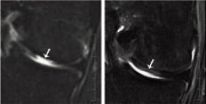(Press-News.org) The result of every possible measurement on a quantum system is coded in its wave function, which until recently could be found only by taking many different measurements of a system and estimating a wave function that best fit all those measurements. Just two years ago, with the advent of a technique called direct measurement, scientists discovered they could reliably determine a system's wave function by "weakly" measuring one of its variables (e.g. position) and "strongly" measuring a complementary variable (momentum). Researchers at the University of Rochester have now taken this method one step forward by combining direct measurement with an efficient computational technique.
The new method, called compressive direct measurement, allowed the team to reconstruct a quantum state at 90 percent fidelity (a measure of accuracy) using only a quarter of the measurements required by previous methods.
"We have, for the first time, combined weak measurement and compressive sensing to demonstrate a revolutionary, fast method for measuring a high-dimensional quantum state," said Mohammad Mirhosseini, a graduate student in the Quantum Photonics research group at the University of Rochester and lead author of a paper appearing today in Physical Review Letters.
The research team, which also included graduate students Omar Magaña-Loaiza and Seyed Mohammad Hashemi Rafsanjani, and Professor Robert Boyd, initially tested their method on a 192-dimensional state. Finding success with that large state, they then took on a massive, 19,200-dimensional state. Their efficient technique sped up the process 350-fold and took just 20 percent of the total measurements required by traditional direct measurement to reconstruct the state.
"To reproduce our result using a direct measurement alone would require more than one year of exposure time," said Rafsanjani. "We did the experiment in less than 48 hours."
While recent compressive sensing techniques have been used to measure sets of complementary variables like position and momentum, Mirhosseini explains that their method allows them to measure the full wave function.
Compression is widely used in the classical world of digital media, including recorded music, video, and pictures. The MP3s on your phone, for example, are audio files that have had bits of information squeezed out to make the file smaller at the cost of losing a small amount of audio quality along the way.
In digital cameras, the more pixels you can gather from a scene, the higher the image quality and the larger the file will be. But it turns out that most of those pixels don't convey essential information that needs to be captured from the scene. Most of them can be reconstructed later. Compressive sensing works by randomly sampling portions from all over the scene, and using those patterns to fill in the missing information.
Similarly for quantum states, it is not necessary to measure every single dimension of a multidimensional state. It takes only a handful of measurements to get a high-quality image of a quantum system.
The method introduced by Mirhosseini et al. has important potential applications in the field of quantum information science. This research field strives to make use of fundamental quantum effects for diverse applications, including secure communication, teleportation of quantum states, and ideally to perform quantum computation. This latter process holds great promise as a method that can, in principle, lead to a drastic speed-up of certain types of computation. All of these applications require the use of complicated quantum states, and the new method described here offers an efficient means to characterize these states.
INFORMATION:
Research funding was provided by the Defense Advanced Research Projects Agency's (DARPA) Information in a Photon (InPho) program, U.S. Defense Threat Reduction Agency (DTRA), National Science Foundation (NSF), El Consejo Nacional de Ciencia y Tecnología (CONACYT) and Canadian Excellence Research Chair (CERC).
New technique uses fraction of measurements to efficiently find quantum wave functions
2014-08-28
ELSE PRESS RELEASES FROM THIS DATE:
Getting graffiti off a masterpiece (video)
2014-08-28
WASHINGTON, August 28, 2014 — Works of art can take years to create and just seconds to deface. It happened to Mark Rothko's "Black on Maroon" while on display at the Tate Modern gallery in London in 2012. A vandal tagged the painting, landing him two years in jail. Restoration experts teamed up with Dow Chemical to create a cleanser that would get rid of the graffiti and leave the art intact. Learn all about it in this episode of Speaking of Chemistry. The video is available at https://www.youtube.com/watch?v=eGR_AxXdSk0 .
INFORMATION:
Speaking of Chemistry is a production ...
Warm thanks: Gratitude can win you new friends
2014-08-28
Parents have long told their children to mind their Ps and Qs, and remember to say thank you. Now the evidence is in on why it matters.
A UNSW Australia-led study has shown for the first time that thanking a new acquaintance for their help makes them more likely to seek an ongoing social relationship with you.
"Saying thank you provides a valuable signal that you are someone with whom a high quality relationship could be formed," says UNSW psychologist Dr Lisa Williams, who conducted the research with Dr Monica Bartlett of Gonzaga University in the US.
The study, to ...
From nose to knee: Engineered cartilage regenerates joints
2014-08-28
Human articular cartilage defects can be treated with nasal septum cells. Researchers at the University and the University Hospital of Basel report that cells taken from the nasal septum are able to adapt to the environment of the knee joint and can thus repair articular cartilage defects. The nasal cartilage cells' ability to self-renew and adapt to the joint environment is associated with the expression of so-called HOX genes. The scientific journal Science Translational Medicine has published the research results together with the report of the first treated patients. ...
Drug shows promise for subset of stage III colon cancer patients
2014-08-28
Bethesda, MD (Aug. 28, 2014) — A subset of patients with stage III colon cancer had improved survival rates when treated with irinotecan-based therapy, according to a new study in Gastroenterology1, the official journal of the American Gastroenterological Association.
When added to the standard chemotherapy treatment — fluorouracil and leucovorin — adjuvant irinotecan therapy improved overall survival rates for patients with the CpG island methylator phenotype (CIMP). CIMP is seen in about 10 to 20 percent of colorectal cancers. Patients with CIMP-negative tumors, however, ...
Saddam Hussein -- a sincere dictator?
2014-08-28
Are political speeches manipulative and strategic? They could be – when politicians say one thing in public, and privately believe something else, political scientists say. Saddam Hussein's legacy of recording private discussions offers researchers a fascinating insight: both into the consistency of this controversial leader's public and private rhetoric and into the bigger picture of conflict and national security during his regime. New research into the similarity between political leaders' public statements and private beliefs, using Saddam Hussein's transcripts, appeared ...
Ontario has one of the highest rates of IBD in the world
2014-08-28
OTTAWA, August 28, 2014 – One in every 200 Ontarians has been diagnosed with inflammatory bowel disease (IBD), with the number of people living with the disease increasing by 64 per cent between 1999 and 2008, according to a study by researchers at the Institute for Clinical Evaluative Sciences (ICES), the Children's Hospital of Eastern Ontario (CHEO), and the Ottawa Hospital Research Institute. That puts Ontario in the 90th percentile for IBD prevalence in the world.
The study, published this week in Inflammatory Bowel Diseases, is the first and largest Canadian study ...
How does it feel to be old in different societies?
2014-08-28
People aged 70 and over who identify themselves as 'old' feel worse about their own health in societies where they perceive they have lower value than younger age groups.
New research from psychologists at the University of Kent, titled 'Being old and ill' across different countries: social status, age identification and older people's subjective health, used data from the European Social Survey. Respondents, who were all aged 70 and over, were asked to self-rate their health.
The researchers found that those living in societies where older people have lower status were ...
Arthritis patients failing to take expensive medication, according to new research
2014-08-28
Twenty seven per cent of rheumatoid arthritis patients in the study who were on a class of drugs known as anti-TNF therapies did not take them as prescribed in the first six months. Patients from Manchester Royal Infirmary were among those from 60 hospitals around the UK involved in the study.
Researchers from the Arthritis Research UK Centre for Genetics and Genomics at The University of Manchester, who led the study, warned that failure to take the drugs correctly, known as 'non-adherence', reduced their effectiveness and may lead to a worsening of patients' disease. ...
Research demonstrates potential method to better control lung cancer using radiotherapy
2014-08-28
Manchester scientists are working out how to safely increase the radiotherapy dose given to lung cancer patients – potentially offering improved local control and survival.
Standard treatment for locally advanced non-small cell lung cancer is a combination of radiotherapy and chemotherapy. Traditionally this is planned in a one-size-fits-all manner but the radiation dose may not always be enough to stop tumour growth.
The potential to increase the radiation dose to the cancerous tissue varies between patients and depends on the size and location of the tumour in relation ...
Dyslexic readers have disrupted network connections in the brain
2014-08-28
Philadelphia, PA, August 28, 2014 – Dyslexia, the most commonly diagnosed learning disability in the United States, is a neurological reading disability that occurs when the regions of the brain that process written language don't function normally.
The use of non-invasive functional neuroimaging tools has helped characterize how brain activity is disrupted in dyslexia. However, most prior work has focused on only a small number of brain regions, leaving a gap in our understanding of how multiple brain regions communicate with one another through networks, called functional ...

